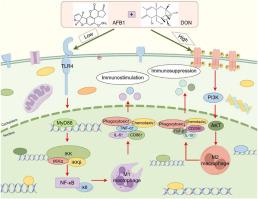Molecular mechanism of the combined exposure to AFB1 and DON in promoting the functional and phenotypic remodeling of porcine alveolar macrophages
IF 3.5
3区 医学
Q2 FOOD SCIENCE & TECHNOLOGY
引用次数: 0
Abstract
Aflatoxin B1 (AFB1) and deoxynivalenol (DON) often coexist and exhibit immunotoxicity. Recent studies have reported that AFB1 and DON exposure alone not only promoted immunosuppression, but also induced inflammation, demonstrating as bidirectional immunotoxicity. Nevertheless, whether the combination of AFB1 and DON exhibit bidirectional immunotoxicity and their mechanism remain unclear. Here, porcine alveolar macrophages were used as an in vitro model, and quantitative real-time PCR (qRT-PCR), Western blotting (WB), flow cytometry, network toxicology and molecular docking were used to investigate the bidirectional immunotoxicity and mechanism of AFB1 and DON combined contamination. Our results showed that the combined exposure of low concentrations of AFB1 and DON (0.005 + 0.5 μg/mL) induced macrophages polarizing to immunostimulatory M1 by upregulating the TLR4-NF-κB, while the combined exposure of high concentrations of AFB1 and DON (0.04 + 4 μg/mL) promoted macrophages polarizing to immunosuppressive M2 by downregulating the PI3K-AKT. The results will provide new insights for the in-depth study of the pathogenic mechanism of AFB1 and DON combined contamination.

AFB1和DON联合暴露促进猪肺泡巨噬细胞功能和表型重塑的分子机制
黄曲霉毒素B1 (AFB1)和脱氧雪腐镰刀菌醇(DON)经常共存并表现出免疫毒性。最近的研究报道,AFB1和DON单独暴露不仅促进免疫抑制,而且诱导炎症,表现出双向免疫毒性。然而,AFB1和DON的联合是否表现出双向免疫毒性及其机制尚不清楚。本研究以猪肺泡巨噬细胞为体外模型,采用实时荧光定量PCR (qRT-PCR)、Western blotting (WB)、流式细胞术、网络毒理学、分子对接等方法研究AFB1和DON联合污染的双向免疫毒性及其作用机制。我们的研究结果表明,低浓度AFB1和DON (0.005 + 0.5 μg/mL)联合暴露通过上调TLR4-NF-κB诱导巨噬细胞向免疫刺激性M1极化,而高浓度AFB1和DON (0.04 + 4 μg/mL)联合暴露通过下调PI3K-AKT促进巨噬细胞向免疫抑制性M2极化。该结果将为深入研究AFB1和DON复合污染的致病机制提供新的见解。
本文章由计算机程序翻译,如有差异,请以英文原文为准。
求助全文
约1分钟内获得全文
求助全文
来源期刊

Food and Chemical Toxicology
工程技术-毒理学
CiteScore
10.90
自引率
4.70%
发文量
651
审稿时长
31 days
期刊介绍:
Food and Chemical Toxicology (FCT), an internationally renowned journal, that publishes original research articles and reviews on toxic effects, in animals and humans, of natural or synthetic chemicals occurring in the human environment with particular emphasis on food, drugs, and chemicals, including agricultural and industrial safety, and consumer product safety. Areas such as safety evaluation of novel foods and ingredients, biotechnologically-derived products, and nanomaterials are included in the scope of the journal. FCT also encourages submission of papers on inter-relationships between nutrition and toxicology and on in vitro techniques, particularly those fostering the 3 Rs.
The principal aim of the journal is to publish high impact, scholarly work and to serve as a multidisciplinary forum for research in toxicology. Papers submitted will be judged on the basis of scientific originality and contribution to the field, quality and subject matter. Studies should address at least one of the following:
-Adverse physiological/biochemical, or pathological changes induced by specific defined substances
-New techniques for assessing potential toxicity, including molecular biology
-Mechanisms underlying toxic phenomena
-Toxicological examinations of specific chemicals or consumer products, both those showing adverse effects and those demonstrating safety, that meet current standards of scientific acceptability.
Authors must clearly and briefly identify what novel toxic effect (s) or toxic mechanism (s) of the chemical are being reported and what their significance is in the abstract. Furthermore, sufficient doses should be included in order to provide information on NOAEL/LOAEL values.
 求助内容:
求助内容: 应助结果提醒方式:
应助结果提醒方式:


